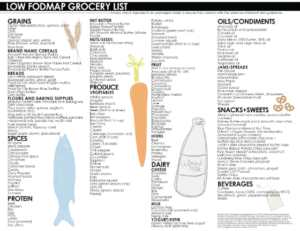If you’ve heard of the FODMAP diet and assume it has something to do with mapping out a plan, you’re not alone.
FODMAP is actually an acronym and also the worst name for a diet to ever exist. If FODMAP sounds clinical and dry, that’s because it is. However, if you have digestive issues that won’t go away, including irritable bowel syndrome, diarrhea, or bloating, you definitely want to hear this.
FODMAP is one of the few diets backed by science to work.
The FODMAP diet is actually much more interesting than it sounds. Here’s why.
FODMAPS (fermentable oligosaccharides, disaccharides, monosaccharides, and polyols) are a specific type of carbohydrate that can lead to excessive fluid and gas accumulation in the gut. The key term to remember is fermentable. This refers to a process that happens to these foods almost as soon as they reach your colon. More on this in a moment.
The FODMAP Diet was developed when researchers at Monash University in Australia were looking for a way to help people with intestinal issues that weren’t responding to conventional treatment. After studying IBS patients, they discovered that by limiting foods high in FODMAPs, symptoms improved. This represented a major breakthrough for people with IBS and other digestive symptoms.
Thanks to the researchers at Monash, a disorder that affects up to 15% of the population finally has a solution.
The results were so compelling that Monash developed an app to make the FODMAP diet easy.
Since the development of the diet, Stanford University and the Mayo Clinic have begun to promote the FODMAP diet as well. Recently, the University of Michigan published the first major U.S. study to investigate the effectiveness of a low FODMAP diet for irritable bowel patients.
After 4 weeks on a low FODMAP diet, patients reported a 67% increase in quality of life.
What People Are Saying about FODMAP
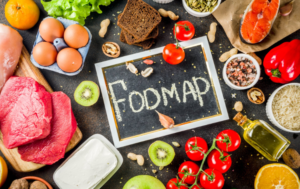
I feel like I’m not sick anymore–it’s changed my identity. I’m a former professional athlete, and I haven’t felt like this in decades. I feel like I could climb mountains, again, literally.
A family member went low-FODMAP a year ago and has gone from feeling icky every day to feeling healthy every day.
I changed my diet and my stomach issues have subsided.
The diet actually works, to my wonder and delight.
What the Heck is a FODMAP?
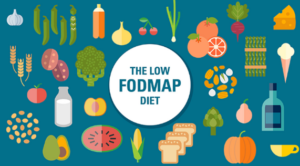
FODMAPs are fermentable sugars (carbohydrates) that are often poorly digested in humans. Not only do they draw water into the intestinal tract like a laxative, but they are fermented by bacteria while they sit in the colon.
The F in FODMAP stands for fermentable. When these carbs aren’t absorbed by the body, they move to the colon where they are rapidly fermented by our natural gut bacteria. This can cause diarrhea and loose or rapid bowel movements. It also causes pain, cramping, and gas. This can be a problem for anyone, especially when eaten in excess.
How do FODMAPs Create Symptoms?

Fermentable oligosaccharides, disaccharides, monosaccharides, and polyols (FODMAPS), create problems for us in two ways.
1. FODMAPs are Osmotic. This means they draw water into the intestinal tract the same way a laxative does. When this happens in the small intestine, you can experience bloating, pain, gurgling or rumbling, and diarrhea.
2. FODMAPs are Rapidly Fermented. Our gut contains plenty of beneficial bacteria we need to maintain a healthy digestive system. When our natural bacteria meet and come across FODMAP carbs in the colon, they feast on them. This leads to excess hydrogen in the gut, which leads to the same kind of symptoms found above in #1.
Monash University has an image illustrating what happens when FODMAPs aren’t absorbed during digestion:
What is the Low FODMAP Diet?
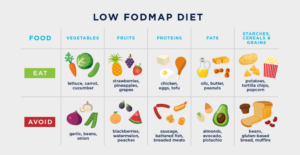
Unlike most of the diets you find on this site, the FODMAP Diet is not for weight loss but is a natural and effective solution to Irritable Bowel Syndrome and other digestive disorders that don’t respond to traditional treatment. The Low FODMAP Diet has been scientifically proven. It relies on food elimination but still provides all the nutrients you need to lead a healthy life. It is not a cure for IBS but it is proven to help prevent symptoms by avoiding triggers.
The Low FODMAP diet is aimed at reducing foods that contain high levels of FODMAP carbohydrates. The list of foods high in FODMAPS is long and includes things like wheat, fructose, and lactose. It even includes some types of nuts and vegetables. No one wants to go on a food-elimination diet, but for those with unending stomach pain, this may be a life-changing solution.
Because it would be impossible to truly eliminate all FODMAP foods, the goal of the diet is to reduce them dramatically for 6 weeks and see if symptoms improve. If a low FODMAP approach is going to work for you, it usually only takes a week or two to see some improvement.
After 6 weeks, re-introduce the foods one by one to find which high FODMAP foods are a trigger for symptoms. It’s worth noting, that the FODMAP diet is not for the unmotivated or casual user. It requires significant discipline and commitment to get results. Portion control of certain FODMAP foods and complete elimination of trigger foods may be necessary to keep IBS symptoms and other digestive problems at bay.
Everyone is different and you may find that simply removing one category of FODMAP (found below) is enough to eradicate your symptoms. In other cases, you may need portion control. While some foods may be such strong triggers, you’ll need to avoid them permanently. The FODMAP diet will be a process of experimentation to determine which FODMAP you are most reactive to. Once you find it (or them), your life may never be the same.
Here’s a link to a quick summary of the FODMAP Diet by Kaiser Permanente.
Benefits of Low FODMAP Diet

The Low FODMAP Diet is Evidence-Based
In addition to Monash University and the University of Michigan, several well-respected medical journals and research-based hospitals have endorsed FODMAP for the treatment of IBS and other intestinal disorders.
The Journal of Gastroenterology and Hepatology concluded, “The low FODMAP diet provides an effective approach to the management of patients with functional gut symptoms. The evidence base is now sufficiently strong to recommend its widespread application.”
Help Identify Food Intolerances
You may not have heard of FODMAP, but you’ve most certainly heard people refer to food intolerances. These are instances where a particular type of food, say gluten or lactose, causes undesirable side effects when eaten. To deal with the issue, the person experiencing symptoms recognizes the food intolerance and goes on a gluten-free or dairy-free diet. The problem is they still experience occasional symptoms. What if the problem isn’t gluten, per se, but a FODMAP found in wheat products? By trying the FODMAP Diet and re-introducing foods gradually, you can more accurately identify your food intolerances. It may not be gluten after all.
Rule Out Food Allergies
Have you found yourself struggling to figure out exactly what in your diet you’re allergic to? You know your symptoms are connected to food, but you can’t nail it down. It’s possible you don’t have a true food allergy, which is a specific immune response. With food allergies, your immune system makes antibodies to food, much like it makes antibodies to a particular virus after you receive a vaccination. Food allergies can be dangerous and even life-threatening. True food allergies can cause inflammatory reactions in the mouth, skin, lungs, and heart—whereas FODMAPs cause symptoms limited to the digestive system.
FODMAP sensitivity is not the same as a food allergy but is often mistaken for it.
The Low FODMAP Diet Works Long Term
Followed correctly, this diet will help you reduce or eliminate symptoms as long as you stick to it. Some people have become completely symptom-free for years following the Low FODMAP Diet.
A retrospective study was published that followed people on the diet for an average of 16 months. Even though they followed a relaxed version of the diet, 86% maintained significant improvement of their IBS symptoms. This study demonstrates the long-term viability of this diet to treat these miserable symptoms. You can read more about it here.
The Low FODMAP Diet has other Health Benefits
The first foods to eliminate FODMAP are those high in fructose. These carbohydrates not only contribute to painful abdominal symptoms, they are also correlated with many other health problems.
Fructose is associated with obesity, high cholesterol, gout, kidney stones, metabolic syndrome, and hyperlipidemia. Considering the risks and the lack of any benefits (we have no dietary need for fructose), the first step in FODMAP may also be the first step to a longer life.
High FODMAP Food Categories
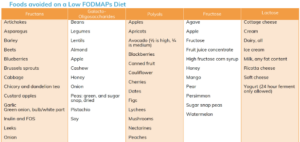
Lactose
Lactose is the primary sugar found in dairy products. When the lactose is not completely digested, it is fermented by bacteria, which produces gastro-intestinal symptoms. Keep in mind, that this is different from a dairy allergy, which is an immune system response rather than an inability to digest.
High FODMAP dairy products include milk from any animal, ice cream, yogurt, and cheese. Before you consider subsisting with soy milk, you should read the section below on Galatians.
Fructose
Fructose is a fruit sugar that occurs naturally in many foods including fresh fruit and honey. It’s found in all types of sugar and high fructose corn syrup. Fructose malabsorption occurs when people cannot fully absorb it. Not surprisingly, there is no dietary need for fructose. Like other unabsorbed FODMAPs, fructose remains in the colon where healthy bacteria feed on it, creating bloating, cramping, and gas.
The highest fructose-containing foods are soda, cola, sweetened beverages, applesauce, honey, agave, fruit juice, apples, and pears. If you drink a lot of soda or fruit juice, you may find significant improvement by simply abstaining from them.
Too much fructose is bad for our health for many reasons and even people without IBS can experience diarrhea and stomach cramping after an overload of fructose. It’s not a bad idea to limit fructose to rare occasions, regardless of what your gut is telling you.
Here is a link to a list of the highest fructose-containing foods.
Galatians
Galatians are a type of FODMAP carbohydrate found in beans, chickpeas, lentils, cabbage, and soy products. These high nutrient, protein-rich foods cause many people to stomach upset and gas because the galactan component cannot be digested in humans. It moves out of the small intestines, along with other forms of fiber, into the colon. Remember, the F in FODMAP is for fermentation, which occurs next.
Polyols
If you were thinking you get away with avoiding sugar and using an alternative, think again. Sugar substitutes like sorbitol, xylitol, and mannitol cause digestive problems as well. Avoid sugar-free gum and other sugar-free foods that find a way to be sweet. Natural or not, sweet-tasting foods contain FODMAPS.
Complaints
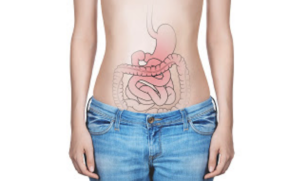
One of the biggest concerns about strict adherence to the FODMAP is the reduction in fiber. Most fruits, several vegetables, and all legumes are high-FODMAP foods. They are also the most common sources of fiber. You don’t have to look far to find overwhelming evidence in support of a high-fiber diet for everything from weight loss to cardiovascular disease.
When you look at all the foods you need to eliminate, the fiber seems to disappear. Keep in mind that foods such as oatmeal are okay and are very high in fiber. Most experts recommend that you don’t stay in the full elimination portion of the diet for longer than three weeks. Soon, you will be adding back in foods and will find high fiber/ high FODMAP foods that you can tolerate without triggering symptoms.
Resources
The most comprehensive site on the web for FODMAP research and IBS treatment is FODMAP Living. You can find all the information you need and more to explore the ways in which you may benefit from this diet.
If you’re looking for a book, we recommend
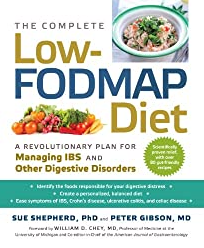
FODMAPS Food List
